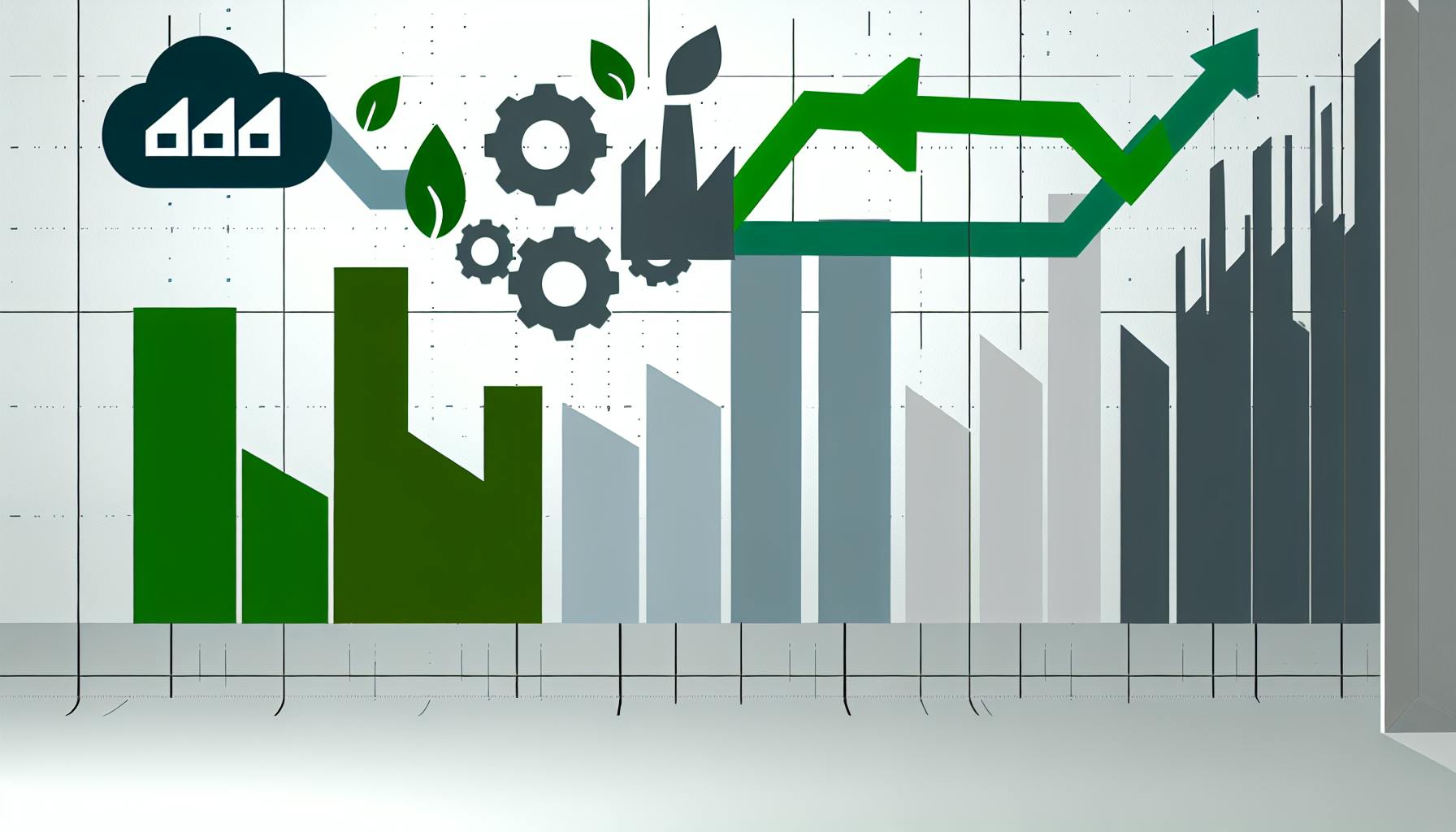Most organizations understand the growing importance of reducing their carbon footprint.
However, small and medium-sized enterprises (SMEs) often overlook opportunities to decrease their climate impact. This article explores the meaning of carbon footprint reduction for SMEs - explaining its significance and providing practical steps any SME can take.
You'll learn key carbon footprint fundamentals, identify strategic sources of emissions, discover target-driven reduction approaches, and view the wider implications of SME climate action.
Why Reducing Carbon Footprints Matters for SMEs
Reducing your carbon footprint is an important step towards building a sustainable business. For small and medium-sized enterprises (SMEs), measuring and lowering emissions can lead to cost savings, risk mitigation, and new market opportunities.
What Does Carbon Footprint Mean?
Your carbon footprint represents the total amount of greenhouse gases emitted directly or indirectly by an individual, organization, event or product. It's measured in tonnes of carbon dioxide equivalent (tCO2e).
The majority of emissions for SMEs generally come from purchased electricity, heating fuels, transportation, and waste. By tracking these activities and finding ways to operate more efficiently, SMEs can significantly lower their environmental impact.
Key Benefits of Carbon Management
- Cost Savings - Improving energy efficiency, reducing business travel, and modifying procurement practices can lead to substantial cost reductions. The money saved drops straight to the bottom line.
- Risk Mitigation - With strengthening climate policies and growing stakeholder expectations, failing to act on emissions poses regulatory, reputational and market risks. Getting ahead of new requirements protects long-term business resilience.
- Market Differention - More customers, especially larger corporates, are factoring sustainability into their purchasing decisions. Demonstrating commitment to emissions reductions can boost sales.
An Opportunity to Lead
Tracking and lowering emissions may seem daunting for resource-constrained SMEs. However automated carbon accounting solutions like EcoHedge greatly simplify the process.
Leveraging these tools, SMEs can efficiently manage their footprint, freeing up time to focus on growing sustainably.
What are examples of reducing carbon footprint?
Reducing your carbon footprint can seem daunting, but it doesn't have to be! Here are 3 easy ways you can start making a difference today:
Use reusable shopping bags
Plastic bags create huge amounts of waste and carbon emissions from manufacturing and transportation. Bring reusable bags with you when you shop to avoid single-use plastics. This simple swap makes a big difference over time.
Eat less meat
The production of meat, especially beef and lamb, generates high carbon emissions. Try going meatless once or twice a week. Experiment with plant-based sources of protein like beans, lentils and tofu.
Drive less
Transportation accounts for around a quarter of global carbon emissions. Reduce your footprint by walking, biking, carpooling or taking public transit whenever possible. If you need to drive, stick to the speed limit and avoid sudden accelerations and stops to save on fuel.
Small, consistent changes to your daily habits can significantly lower your carbon footprint. Focus on areas where you have the most impact. Every sustainable choice makes a difference!
What is an example of carbon footprint?
For example, we produce greenhouse gas emissions from burning gasoline when we drive, burning oil or gas for home heating, or using electricity generated from coal, natural gas, and oil.
Transportation carbon footprint
One of the most significant examples is your transportation carbon footprint. This refers to the greenhouse gases emitted as a result of your personal transportation choices. For example:
- Driving a petrol or diesel car releases emissions like carbon dioxide and nitrous oxide. The more you drive, the higher your transportation footprint.
- Air travel has the highest emissions per passenger kilometer. Taking one return flight can contribute a high share of an individual's overall footprint.
Reducing how much you drive and fly is an impactful way to cut your transportation carbon footprint. You can also choose more sustainable options like electric vehicles, public transportation, cycling, and walking.
What is carbon footprint and why is it important?
A carbon footprint refers to the amount of greenhouse gases (GHGs) released into the atmosphere from an individual, organization, event, or product. It's an important measurement of environmental impact that contributes to global climate change.
Reducing carbon footprints is crucial for combating climate change and building a sustainable future. Here are some reasons why lowering carbon emissions matters:
- Climate change threatens ecosystems, economies, infrastructure, and human health worldwide. Rising global temperatures lead to extreme weather events, droughts, food shortages, species loss and more environmental issues over time.
- Carbon footprints track the GHG emissions contributing to climate change. By understanding carbon footprints, we can identify the biggest polluters and opportunities to lower emissions through changes in energy, transportation, manufacturing, agriculture and land use.
- Businesses face increasing legislation, regulations, taxes and reporting requirements related to sustainability performance and carbon impacts. Those managing GHG risks and emissions effectively will maintain a competitive edge.
- Consumers and investors now favor brands with strong environmental commitments and transparent sustainability reporting. Lower carbon footprints allow companies to tap into growing ethical consumerism and attract green financing opportunities.
In summary, carbon footprints quantify climate impacts that threaten society. Monitoring and reducing emissions is essential for environmental sustainability and serves as a key pillar of ESG risk management.
How can you reduce your carbon footprint at work?
Reducing your carbon footprint at work is an important step towards creating a more sustainable business. For SMEs, implementing eco-friendly practices in the office can significantly lower emissions while also reducing operating costs.
According to the EPA, commercial buildings account for nearly 20% of U.S. greenhouse gas emissions. With rising energy costs and climate change concerns, businesses have a responsibility to limit wasteful practices by improving energy efficiency.
The term "carbon footprint" refers to the total emissions caused directly and indirectly by an individual, organization, event or product. It is often expressed as a carbon dioxide equivalent. So reducing your carbon footprint means lowering the amount of greenhouse gases emitted into the atmosphere.
Some activities that contribute heavily to a company's carbon footprint include:
- Heating and cooling office spaces
- Powering office equipment and appliances
- Business travel via planes, trains and automobiles
- Disposing of waste and food
Luckily, there are many affordable and practical ways SMEs can shrink their environmental impact right from the office.
Choose Energy Efficient Appliances
Replacing outdated refrigerators, microwaves and other appliances with ENERGY STAR rated models can significantly reduce electricity usage. Smart thermostats, motion sensor lights and automatic computer shut-off switches also minimize power drain.
Switch to LED Light Bulbs
LED bulbs consume at least 75% less energy than traditional incandescent lighting. Though more expensive upfront, they last 25 times longer – saving money and emissions over time.
Adjust the Thermostat
Simply setting office heating to 68°F and cooling to 78°F can diminish energy use by up to 20 percent. Smart programmable thermostats take convenience a step further by automatically adjusting settings during closed hours.
Go Paperless
The paper industry is quite resource-intensive, requiring large amounts of wood, water and energy. Transitioning to digital workflows for documents, billing, marketing and beyond cuts costs and saves trees. Added bonus: less printing means fewer ink cartridge replacements.
Provide Recycling Stations
Enabling employees to properly sort paper, plastic, glass and electronics diverts waste from landfills and gives these materials renewed purpose. Some local recyclers will even pay for certain scrap metals or tech gear.
By taking small but consistent action, SMEs can profit from efficiency while responsibly managing their environmental impact. lower utility bills, tax incentives and positive public perception. Beyond benefiting the planet, sustainability efforts build employee, customer and community goodwill by demonstrating an enlightened corporate philosophy geared toward positive progress.
Carbon Footprint Fundamentals for SMEs
Understanding your company's carbon footprint is essential for SMEs looking to improve their sustainability performance. Let's explore what constitutes a carbon footprint, why it matters, and how to calculate it.
Defining the Carbon Footprint
A carbon footprint refers to the total greenhouse gases emitted into the atmosphere from direct and indirect business activities. It is measured in tons of carbon dioxide equivalent.
Reducing your carbon footprint entails lowering energy use, switching to renewable power, improving efficiency in operations and transportation, and offsetting unavoidable emissions. This helps mitigate climate change risks, achieve compliance, boost reputation, and identify cost savings.
For SMEs, the most significant carbon emissions often come from purchased electricity, transportation, distribution channels, supply chains, and product manufacturing.
Activities That Contribute to Carbon Footprint
The main activities that contribute to an SME's carbon footprint include:
- Business travel (flights, hotel stays, commuting)
- Transportation of goods via shipping carriers
- Purchased materials, goods, and services throughout the supply chain
- Waste generation and water usage on premises
- Use of fossil fuels for heating/cooling buildings and running facilities
- Electricity usage for lighting, equipment, appliances etc.
Switching to renewable energy, improving energy efficiency, reducing business travel, optimizing logistics, and diverting waste from landfills can significantly lower emissions.
Calculating the Carbon Footprint
SMEs can calculate emissions using:
- Carbon calculators - Easy online tools that estimate footprint based on utilities, travel, materials etc.
- Product/company lifecycle assessments - Detailed evaluations of emissions across the entire lifecycle of goods/services.
- Greenhouse Gas Protocol - A comprehensive, standardized framework to account for and report GHG emissions.
The data required includes energy and fuel usage volumes, transportation mileage, waste disposal amounts, and other company activities tied to climate impact. Automated carbon accounting software like EcoHedge Lifecycle can facilitate accurate GHG calculations.
Accurately determining your company's carbon footprint lets you identify "hot spots" to target for abatement. This is key for SMEs on the path towards net zero emissions.
sbb-itb-919600f
Strategic Sources of Emissions in SMEs
Reducing your carbon footprint meaning for small and medium-sized enterprises (SMEs) starts with identifying the key sources of greenhouse gas emissions within business operations. By understanding where emissions originate, companies can develop targeted reduction strategies.
The main sources of emissions for SMEs typically fall into three categories:
Facilities and Operational Emissions
The usage of electricity, heating, and cooling in company buildings and facilities often makes up a significant portion of an SME's carbon footprint. Simple changes like switching to renewable energy, improving insulation, installing smart thermostats, and replacing old appliances with energy efficient models can reduce energy consumption. SMEs can also analyze production processes and implement eco-design principles to limit waste and material usage.
According to the Environmental Protection Agency (EPA), improving energy efficiency in commercial buildings can reduce carbon emissions by over 50 million metric tons per year in the United States alone. With rising energy costs and climate impact in mind, evaluating and optimizing facilities is an effective way for SMEs to shrink their carbon footprint. Reducing energy consumption directly lowers emissions while also saving money over time.
Transportation's Role in Carbon Emissions
Business travel and product distribution are major contributors to transportation emissions. With companies relying on freight, shipping, corporate jets, and more, these sources accumulate dramatically. SMEs can reduce mileage by organizing carpools, avoiding unnecessary trips, purchasing carbon offsets, and shifting to electric fleet vehicles.
Prioritizing green logistics for procurement and deliveries further alleviates emissions from transport. Localizing supply chains also helps diminish carbon output from global freight movements. As online shopping grows exponentially, small changes in distribution and fulfillment greatly benefit the planet.
The Impact of Supply Chain Choices
Upstream supply chain emissions constitute over 75% of the total carbon footprint for many SMEs. Evaluating environmental impacts during sourcing and purchasing thus allows companies to shrink their indirect emissions. Analyzing supplier sustainability reports, minimizing excess product packaging, and reducing overall material consumption can make wide-reaching positive change.
Many SMEs also overlook employee commutes as part of their carbon footprint from transportation. Encouraging carpools, public transit, cycling, and remote work options for personnel can further chip away at emissions. With holistic assessment of all direct and indirect sources, SMEs can map strategic pathways to reach ambitious environmental targets.
Target-Driven Carbon Footprint Reduction
Reducing your carbon footprint is a key component of any sustainability strategy. For small and medium-sized enterprises (SMEs), setting clear, realistic, and impactful emissions reduction targets helps provide focus and accountability in climate action plans.
Baseline Metrics for Target Setting
Choosing an appropriate baseline year and emissions benchmark is crucial for tracking progress towards carbon reduction goals over time. Most companies select a baseline year when emissions data collection was robust, such as the past 12-36 months. Common baseline emissions benchmarks include per unit of production, per full-time employee, or absolute emissions for a typical year of operations. Comparing current emissions to a fixed historical baseline offers an "intensity" ratio to quantify reduction achievements.
Importance of Reduction Goals
Defining "the importance of reducing your carbon footprint" with tangible objectives motivates sustainability efforts. Targets give stakeholders a clear milestone to work towards. Goals also enable companies to measure and demonstrate progress in lowering climate impact. For example, an SME may set a goal to reduce scope 1 and 2 emissions 25% by 2025 off a 2019 baseline. Achieving incremental targets year-over-year helps maintain momentum.
Focusing on High-Impact Reduction Activities
The activities that contribute most to a carbon footprint often yield the largest reductions when addressed. Most SME emissions come from transportation, energy usage, supplies & materials, and waste. Analyzing your company's hotspots guides high-ROI actions like improving fleet MPG efficiency, purchasing renewable energy credits, reducing business travel, or diverting waste from landfills. Small emission reduction changes across these areas compound over time for significant bottom-line carbon and cost savings.
Practical Approaches to Carbon Footprint Reduction
Reducing your carbon footprint is an important step towards building a more sustainable future. For small and medium-sized enterprises (SMEs), lowering emissions can seem daunting, but it doesn't have to be. There are many practical, achievable measures SMEs can take to shrink their carbon footprint.
10 Simple Ways to Reduce Your Carbon Footprint
Here are 10 simple ways SMEs can start reducing their carbon footprint today:
- Conduct an emissions audit to understand your current carbon footprint. Tracking emissions over time allows you to set reduction goals and identify high-impact areas to address first.
- Switch to renewable energy sources like solar or wind power. This dramatically decreases the greenhouse gases associated with fossil fuel-based electricity.
- Improve energy efficiency by replacing old appliances and equipment with ENERGY STAR certified options. Smart heating and cooling systems also optimize energy use.
- Reduce business travel emissions by limiting flights and accommodating remote work and virtual meetings when possible.
- Offer sustainability training to employees to build awareness around environmental impact and nurture a culture focused on carbon reduction.
- Switch fleet vehicles to electric or hybrid models to lower transport emissions. Encourage employee commuting by bike or public transit.
- Adopt environmentally conscious procurement policies, like buying locally sourced goods or choosing products and materials with smaller carbon footprints.
- Promote recycling and composting to reduce waste ending up in landfills, where it emits methane gas as it breaks down.
- Allow adjustable thermostats, smart lighting, and other systems for employees to control energy use at their workstations.
- Offset remaining emissions each year by investing in certified carbon reduction projects like reforestation or renewable energy.
Taking even small steps to be more eco-conscious can significantly decrease your SME's carbon emissions over time.
Sustainable Procurement and Energy Efficiency
From office materials to major equipment purchases, the sustainability of an SME's procurement decisions plays a major role in its carbon footprint. Evaluating the environmental impact of products and services should be an essential part of the procurement process.
Prioritizing green suppliers and energy efficient technologies helps to directly avoid emissions through daily operations. For example, buying recycled paper goods, efficient HVAC systems, and products with ecolabel certifications are solid choices. Local and seasonal food options for meetings and events also reduce transport miles.
It's equally important to factor in the full lifecycle emissions of purchases, all the way from raw material extraction through production, transport, use, and disposal. Thinking long-term about procurement through this sustainability lens helps minimize waste and energy demands over time.
The Transition to Renewable Energy Solutions
The path to major carbon footprint reductions runs directly through renewable energy sources like solar, wind, geothermal, and hydropower. The great news is that prices for renewables have fallen dramatically, making on-site solar panels or renewable energy subscriptions affordable options for SMEs eager to shrink their climate impact.
Depending on location and budget, SMEs can take advantage of policies supporting community solar gardens, virtual net metering, or certified renewable energy credits (RECs) attached to regional clean power projects. Where viable, installing rooftop solar panels generates renewable energy and also insulates companies from utility rate hikes.
Pairing renewable power with smart energy storage solutions allows SMEs to cost-effectively align demand with solar or wind generation times for further gains. For any hard-to-eliminate emissions, trusted carbon offset purchases can counterbalance remaining impacts too.
Over the long run, SMEs stand to benefit immensely from joining the accelerating global transition toward renewable energy. Taking the leap positions SMEs as sustainability leaders while future-proofing operations against emissions regulations, carbon taxes, and climate uncertainty. Most importantly, powering your SME renewably signals your stakeholders and community that you're serious about reducing your carbon footprint meaning for the good of both environment and business.
Monitoring Reduction Efforts and Reporting Success
Reducing your carbon footprint is an ongoing journey that requires careful tracking of emissions data and progress over time. For small and medium-sized enterprises (SMEs), having the proper tools to measure and monitor carbon reductions is key to success.
Tools for Measuring Carbon Reductions
Solutions like EcoHedge Lifecycle provide automated carbon accounting that makes it easy for SMEs to calculate emissions from various sources. By connecting data from utility bills, logistics records, travel receipts, and more, the software can quantify carbon output across the full lifecycle.
Dashboards and reports let you see emission trends across scopes, business units, or time periods. This insight empowers smarter strategies to reduce your carbon footprint meaning the environmental impact.
- Electricity usage
- Transportation fleets
- Supply chain activities
- Waste generation
With accurate carbon accounting, you can set baselines, emission reduction targets, and track performance versus goals.
Transparency in Carbon Reduction Reporting
Communicating sustainability initiatives openly and honestly with stakeholders builds trust. Software solutions like EcoHedge Engage simplify carbon reporting tailored to investors, customers, regulators, employees, and the public.
Transparency establishes your company as an ethical leader committed to ecological stewardship. It demonstrates investing in emissions reductions ultimately benefits the bottom line through:
- Improved brand reputation
- Competitive edge for proposals
- Stakeholder satisfaction
- Regulatory compliance
Continuous Improvement in Carbon Management
Achieving ambitious sustainability requires regularly assessing performance and refining your company's carbon strategy over time.
EcoHedge's interactive dashboards display the real-time status of emissions versus targets. This allows quick identification of problem areas needing intervention.
As your business evolves, so do the sources of emissions. Continuously monitor your carbon footprint meaning for new operations, acquisitions, services, or locations.
Updating reduction plans ensures you maintain momentum decreasing environmental impacts. Celebrate milestones like hitting net-zero emissions, but understand the journey of improving climate stewardship never truly ends.
The Path to Net-Zero: An SME Perspective
Understanding the pursuit of net-zero emissions and its implications for SMEs striving for environmental and economic sustainability.
Understanding Net-Zero Objectives
Achieving net-zero emissions means that a company removes as much greenhouse gas emissions from the atmosphere as it emits. This ambitious sustainability goal aims to drastically reduce emissions output while balancing out any remaining emissions to achieve an overall neutral environmental impact.
For SMEs, pursuing net-zero objectives signals a strong commitment to tackling climate change. It requires measuring carbon footprint across operations, setting science-based emissions reduction targets, executing decarbonization strategies, and potentially investing in certified carbon removal projects to neutralize stubborn emissions. Meeting net-zero goals takes long-term planning, investment, and perseverance.
The first critical step is to calculate your company's carbon footprint meaning - the total greenhouse gas emissions produced directly or indirectly from its activities. Understanding your carbon footprint establishes a baseline to track progress and identifies priority areas to reduce environmental impact.
Common sources of emissions for SMEs include energy usage, transportation, supply chain processes, water usage, waste output, and more. Assessing emissions across these areas using established greenhouse gas accounting protocols gives a comprehensive view of your total climate impact.
Prioritizing Emissions Reduction Before Offsetting
While carbon offsets present a mechanism to balance unavoidable emissions, the priority is minimizing your company's emissions output in the first place through reductions strategies. This aligns with the principles of avoiding and reducing emissions before considering compensation.
Implementing emissions reduction initiatives not only lessens environmental harm, but can achieve cost savings through efficiency gains. Steps like improving energy efficiency, substituting high-emission processes, investing in renewable power, electrifying vehicle fleets, reducing business travel, or modifying procurement policies to favor low-carbon vendors all contribute to shrinking your carbon footprint.
Executing emissions reduction projects requires upfront investment but generates both climate and economic returns over time. And flaunting your company's measurable emissions cuts and sustainability success stories helps attract environmentally-conscious investors, customers and talent.
Utilizing Offsets to Neutralize Remaining Emissions
Despite best efforts to implement every possible emissions reduction strategy, most SMEs will still face some stubborn fossil fuel-related or industrial process-related emissions challenging to eliminate completely with current technology.
Here is where high quality carbon offsets can help address residual emissions - each offset certificate represents an equivalent ton of CO2e sequestered or avoided elsewhere through renewable energy, reforestation or other certified climate projects. Retiring these credits neutralizes hard-to-abate emissions, enabling a company to attain carbon neutral or net-zero status.
Offsets enable SMEs to make claims of net-zero operations today while technology catches up to completely phase out reliance on fossil fuels. However, organizations must still aggressively work to reduce their own emissions through all feasible means rather than overly depend on offsets as a panacea. Offsets complement reduction efforts, but should not be viewed as a free pass to continue polluting.
Pursuing net-zero aligns with both environmental and economic goals for forward-looking SMEs. With some planning, investment and grit, carbon neutrality is within reach.
Wider Implications: SMEs and Global Carbon Emission Reduction
Examining how collective efforts by SMEs contribute to 'ways to reduce carbon emissions globally' and foster a more sustainable future.
Reducing carbon emissions is a global effort that requires participation from businesses of all sizes. Though multinational corporations tend to draw the most attention, small and medium-sized enterprises (SMEs) have an important role to play as well. When many SMEs work to lower their carbon footprints, the combined impact can drive significant progress towards worldwide emission reduction targets.
Collective Carbon Reduction Power of SMEs
While a single small business may seem insignificant compared to massive conglomerates, SMEs make up over 90% of businesses worldwide. Their actions to limit climate impact, when aggregated, carry tremendous influence. Simple changes like improving energy efficiency, reducing business travel, or purchasing renewable energy may appear minor for one company. But on a global scale, millions of SMEs pursuing carbon reduction adds up to greatly curtailed emissions.
SMEs also have advantages in adapting operations for sustainability. Their smaller size allows more flexibility to implement changes quickly. Large enterprises with complex bureaucracies often progress slowly. SMEs can pivot faster in response to emission regulations, consumer demands, investor pressures, and technology shifts. Their agility positions SMEs to lead on progressive environmental policies.
The Ripple Effect of SME Sustainability
Beyond direct influence on emissions, SMEs drive wider market transformation through ripple effects. As small businesses implement carbon accounting tools, renewable energy sources, electric fleet vehicles, responsible supply chain policies, and other solutions, they demonstrate feasibility for broader adoption. Their proven examples compel other businesses to follow suit.
SMEs also provide sustainability leadership up and down supply chains. A small company can require vendors to disclose and reduce emissions, spreading accountability. That SME's large corporate customers may then make the same demands, propagating positive impact. These ripples from SME action result in industry-wide emission cuts over time.
The Next Wave of Progress
SMEs have only begun to exercise their potential to address climate change. Simple yet consistent carbon reduction steps by small businesses globally can drive tremendous progress. The message for SMEs is clear - your sustainability efforts matter. While each emission cut may seem minor, combined they create waves of change leading to a low-carbon future. The time for action is now.
Concluding Thoughts: The Importance of SMEs in Combating Climate Change
Small and medium-sized enterprises (SMEs) have a crucial role to play in reducing global carbon emissions. Though individual SMEs may have a relatively small carbon footprint, collectively they account for a substantial portion of commercial energy use and greenhouse gas outputs. By measuring, reporting, and proactively working to decrease their carbon footprints, SMEs can contribute meaningfully to worldwide climate change mitigation efforts.
Some key reasons why SME engagement on emissions reduction is so vital:
- SMEs make up over 90% of businesses globally. With their sheer numbers and workforce size, SME climate actions can drive large-scale change.
- SMEs are major energy consumers. From offices to factories to fleets, SMEs use lots of power - meaning they also have lots of room for efficiency gains.
- SMEs face growing stakeholder pressures. Employees, customers, investors and more increasingly expect firms to address sustainability.
Transitioning SME operations to cut carbon is an urgent priority - but also a major business opportunity. Beyond environmental benefits, studies show sustainability-focused SMEs often see cost savings, revenue growth, talent retention and other concrete bottom-line upsides.
By taking advantage of automated and easy-to-use tools to track and reduce emissions, SMEs can make an outsized contribution to worldwide climate protection efforts while future-proofing their organizations.



.png)


